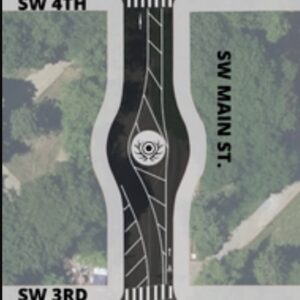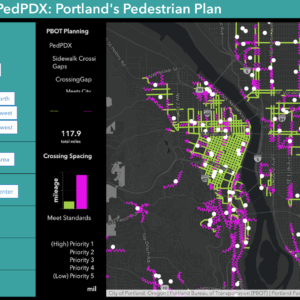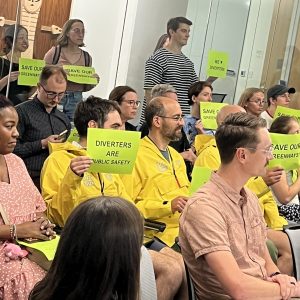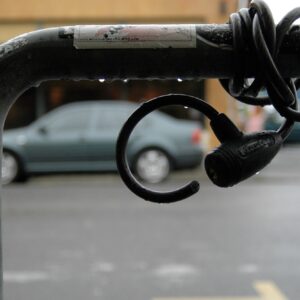
and plants coexist.
(Photo © J. Maus)
Portland Mayor Sam Adams has released details of his promise to find $20 million to “kickstart” funding of the 2030 Bike Plan. As expected, the money will come from the Bureau of Environmental Services budget and will be allocated toward “Green Streets projects on prioritized boulevards.”
As we pointed out last month, “Green Streets” is the name of a BES program that manages stormwater runoff through street designs that incorporate things like permeable pavers, vegetation, and bioswales. The Bureau of Transportation has worked in partnership with this program for years because some green street features — like curb extensions — are also used on bicycle boulevards.
The ordinance to be voted on this Wednesday will be considered as an “emergency ordinance” and will take effect immediately. According to language in the ordinance, an emergency exists because “the timeframe for completion necessitates beginning project development and outreach immediately.”
The projects prioritized for this funding have already been identified in the 2030 Bike Plan.
Here’s another blurb from the ordinance that explains Adams’ justification for using BES Green Streets money for bike projects:
“Investing in green street features and bicycle transportation has the potential to achieve the most cost-effective and rapid implementation of the concurrent goals of the Green Streets Policy, the Bicycle Plan for 2030, the Climate Action Plan and other City objectives.”
The $20 million would be available for projects to be completed by June 2013. After that date, the ordinance states that BES will work with the Bureau of Transportation to “identify $2 million per year in additional project opportunities” that would also be funded by BES beginning in July 2014 “and beyond.”
For more coverage, and to download a document that explains how the BES budget will be impacted by this reallocation of funds, read this story by The Portland Mercury.






Thanks for reading.
BikePortland has served this community with independent community journalism since 2005. We rely on subscriptions from readers like you to survive. Your financial support is vital in keeping this valuable resource alive and well.
Please subscribe today to strengthen and expand our work.
I think it is amazing he found $20 million when he cant find the money nec. to repair and maintain the streets
Don’t raise my sewer costs for your pet project Sam. If bikers want it then let them pay for it with a bike registration fee.
This is just a cash grab from outer Portlanders to support the wealthy inner city clique.
Adams thinks Portland stops at SE 39th.
@ posts 1 & 2:
This money is going towards repairing and updating the streets while reducing your sewer bill in the long run (since the runoff from the renovated streets is treated for contaminants by the bioswales and released into the ground, not into the sewer system). And, read again, the money is coming from the Bureau of Environmental Sciences, which is surely not going to fund projects for streets that bolster car culture behavior. Even though, were it not for oil-dripping automobiles and their requirements for smooth paved surfaces, bioswales would not be necessary in the first place.
It seems like this project does take into account outer-city Portlanders after all.
Be happy that bike specific infrastructure is moving the cyclists out of your way so you can drive faster.
My sewer bill is high right now to pay for a $billion+ sewer project. Not to pay for bicycle infrastructure. This is just more tax and spend beyond anybodys means. If there is money left over because the project is under budget than the money should refunded to ones who paid it. what if your mechanic said $500 to fix your car but fixed it in 30 minutes? should he keep the $500?
I support the Bike/Pedestrian Master Plan. It benefits everyone in some way, saving on the general populations health care costs, by reducing bike/car conflicts, obesity and cleaner air (that we all breath), just to name a few. I think the BES money is a stretch, but it’s only temporary. Now that the B/PMP has passed it’s time for the Bike Community to focus it’s energy & ideas or where “Stable” funding can come from. Sam is forming a group to review the options, contribute. It’s like winning the Olympic Bid, now we have to actually build it.
To the above people (1,2,4) who complained about the spending. Why not focus your energy on banning studded tires, their chewing the S___t out of our roads and no one says a thing. Only 10% of people use them in Portland yet, drive our roads, their totally ruined and rutted. Our food comes on that road, it’s in our best interest to protect them. That’s hundreds of millions of dollars that we could save and use for the B/PMP & still have money left over.
seconding comment 6, i see several cars each day running studs. what the hell? what kind of sociopath does that?
This is smart use of public funds to achieve multiple public goods in a cost-effective manner. The Mayor and city staff deserve kudos for making Green Street and Bike Blvd implementation a priority.
The overweight trucks do 100 times more damage than studs. 50 years ago they didn’t allow such heavy trucks on the roads because they knew what kind of damage they would cause. Lobbiest’s for the trucking companies gradually got the govt. to increase the weight limits in the name of the almighty dollar to the point where our roads just can’t stand up to it anymore and our local leaders do not have their priorities set right to try and maintain the roads before they need extra costly repairs. Instead they have pet projects that they spend our money on and at the same time cut basic services and lay off public employees, and let people out of jail.
there was a plan for “Simple Green Street” where these projects could be done with minimal amount of work. It seams that they keep getting more complicated and more labor intensive
Energy needs to be focused on RECALLING SAM ADAMS
Wow, I think the Oregonlive.com commentators finally found this site. *sigh*
Nah…the oregonlive commentators are far crazier. These “guys” are card carrying members of the portland archie bunker society (aka bojack.org).
Storm water swales capture pollution from automobiles…oil, gas and tires; reducing the number of auto trips by shifting them to bikes reduces that pollution. BTW, the entire cost of the Big Pipe has been borne by ratepayers, but the bulk of the pollution captured by the $1.5 Billion project comes from motor vehicles, the owners of which have paid nothing.
Now, as to the cost of air pollution from our “toxic rivers” aka freeways, none of that is covered by owners of motor vehicles either. Bicyclists should be paid to ride as we contibute virtually nothing to our toxic air and water.
Lenny-
Do you grow all your own food?, clothes, all that other stuff you consume? If not than YOU are contributing to the stormwater runoff. All those goods are delivered in trucks (big heavy deisel spewing trucks) Do live in a house or an apt that the water runs off the property into the street? if you do than YOU contribute to the storm drains, unless maybe you have an onsight facility to handle that runoff. Do you use the public highway? It belongs to you and the water is going to run off of it regardless if you are on a bike or a car.
You seam to think the swales are built to capture pollution, wrong- they are built to keep excess water out of the sewer system. It is to benifit homeowners not cars. Stop trying to twist this into something its not. There is no justification that bikes should get a free ride in liu of it all
I’m a cyclist like most everyone here and generally support most anything that has to do with bikes. But this is a politically risky move at best. I’m not sure it’s really the way we want to fund this stuff.
So sad these strange people who showed up here can’t think very clearly. So, let’s do a few thought problems.
1) If a lot of cars and trucks pollute a lot, fewer cars and trucks pollute less. If I can replace most of my car trips by bicycle, and still depend on trucks to deliver some of the goods I buy — even bikes! — I am not being a hypocrite. I am being proportional, since transit is not a binary switch. Try to get around that idea, please.
2) Car registration fees and gas taxes do not cover all the spending on roads. Should I, an infrequent driver, be OK with that, even though I am subsidizing other road users, who utilize this shared space more heavily than I do?
3) Likewise, should money spent on bicycle infrastructure be borne by the cyclists alone? What if it benefits more people than just the cyclists. What if, when you think clearly, it benefits drivers, who have to share the road with fewer other cars, and who will have to spend less in taxes on road maintenance. Coould it be that money spent on bike lanes generates much more money saved on road repairs.
4) Ask yourself: would you rather live in a house 50 feet from a freeway, 50 feet from a busy surface street like Powell or 39th, or 50 feet from a bike boulevard? (If you answered either of the first two, you should spend some time doing real estate comps.)
5) If overweight trucks are a problem, are they still a problem if they are delivering your food from a farm? Think clearly, and try not to contradict yourself. (Hint: it’s complicated, and you might find that people who oppose studded tires also oppose overweight trucks, and that it’s possible to move food from farms to people without using either studded tires or overweight trucks)
Now that we got that out of the way, let’s get back on topic. Why is it ok to spend money for sewers on bike projects?
a. Because there is a lot of overlap with the green streets program, in terms of actual, designed projects.
b. Because the two main problems with runoff — too much water, and pollution in the water — are intertwined. If all runoff were crystal clear, we wouldn’t care how much of it ran straight into the river. It’s because it’s polluted that we have to worry about it, and to manage the flow. Reducing auto traffic does indeed have a lot to do with the runoff problem, because it reduces pollution.
c. Both are true.
I’m going with c.
if the water were crystal clear and flowed straight into the drain the system would still overflow sending raw sewage into the river
This is probably one of the most ludacrous things Sam has come up with yet. Stealing money from sewer to pay for bikes. It is sure to speed up his recall
jim:
I know you’re our resident troll, so I shouldn’t even engage you, but, seriously, do you not even pay attention? Are you that incapable of getting your head around the simple idea that BIKE INFRASTRUCTURE BENEFITS PEOPLE WHO DON’T EVEN RIDE BIKES AND SAVES MONEY FOR EVERYONE?
See, jim, you can go on hating bikes and bikers, and STILL win with the Bike Plan! You can drive your big fat truck anywhere you want, and wait in less traffic, while paying less in taxes because the roads last longer. What’s not to love?
Did bikes just save me 20 million off of my sewer bill? don’t think so. or the 600 million (or the anticipated billion plus) for bike infrastructure?
Is not saving me anything.
jim (or whoever your legal guardian is):
If spending 600 million over 20 years (thats 30 million a year, or 5% of the transportation budget) ends up saving at least 30 million a year in road repair costs and unneeded road expansion costs, wouldn’t it be worth it? What about the deaths and injuries from the car crashes that did not happen (and all costs that go with cleaning up after those crashes), health costs from fitter children and adults who get to breathe cleaner air?
What about the fact that 5% of the transit budget could go towards supporting the needs of 25% of all trips made in Portland? Sounds like a bargain, no?
Of course you’d rather spend that $600 million on 1/7th of one transportation project — the CRC — which won’t solve anyone’s problems one year after it’s built. I guess that makes more sense, doesn’t it?
$600 million: twenty years of infrastructure to support 1/4 of all trips taken in PDX, or 1/7 of one useless bridge?
What about the $600 million plus of road repairs that they can’t find the money for?
I don’t know, jim. I didn’t break the roads with my 19lb bike. You and your big truck did. Deal with it.
since the demise of horse and buggy those roads are made for cars and trucks. Deal with it
I never said I have a big truck
A bridge does make a lot more sense
Roads were first paved as a result of pressure from cyclists. Look it up. Prior to being paved, they existed for people, and they are the single biggest public space, i.e.: not private property in this country, taking up more area than all our national parks put together.
the oregon trail was used by wagons, not bikes. the same for most of the roads here- they were made for wagons which were replaced with cars and trucks. paving had nothing to do with bikes.
peejay, if such budgeting logic were really defend-able, we could justify spending the defense budget on free college education. Because having an educated and prosperous populace is more likely to lead to contentment as a nation and less call for war like policies. I’m not saying those two aren’t related; they probably are. But it’s just not the way budgets should be created.
k.
No, instead we have an ever-increasing defense budget, with the occasional war thrown in to justify the big budget.
And anyway, if you’re not disputing my numbers, what’s wrong with the strategy? I don’t get it. Here’s a better analogy: Say I spent $2000/year to heat my house, and I put that much in the budget for it, and have no money left over for home improvement. Now, I find out that I can pay $500 to insulate my house, and it would save at least $250 a year. Of course I would spend that money, even if it meant I’d be short for the first year, because after the second year, I’d break even, and by the third year (and every year after), my heating cost goes down by 25%.
Your logic says: well, you just can’t divert that money from one budget item to another, no matter what the outcome will be, even if you save money in the long run.
jim:
Here’s one link that proves you’re wrong about the origins of paving. There are many others. Google is my friend.
Broken link. Try
http://www.greentechhistory.com/2009/05/how-bicyclists-built-the-roads-that-carried-the-cars-that-pushed-them-off-the-roads/
Peejay-
Thanks for the link. I do enjoy history, and I liked the picture of the original “tall bike”. I am sure no expert on the origins of paving. I bet it was a pretty bumpy ride on the cobblestones before they put paving on top of them. It’s a shame in many ways that we have paved the planet. To bad it’s all the fault of some early day cyclists
jim:
How about we tear up all the concrete and asphalt, and put in pervious pavement like they do for driveways and some parking lots? Would solve runoff problem, too. Only problem: it’s not compatible with heavy auto traffic. Oh, that’s a win, too.
I can just see it. bikes with little trailers hauling away all the concrete, grinding it up into gravel to make bike paths. maybe small villages with radial shaped pathes leading to homes and comunity farms… sigh
Actually, the ideal car-free place is a city.
how do you bring in goods for all those people?
how are they going to build the city without cars and trucks?